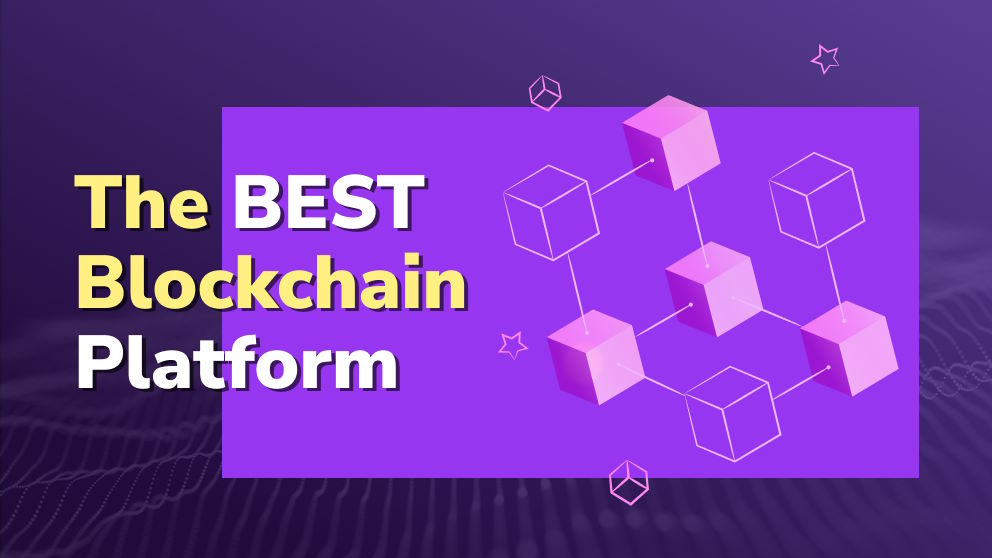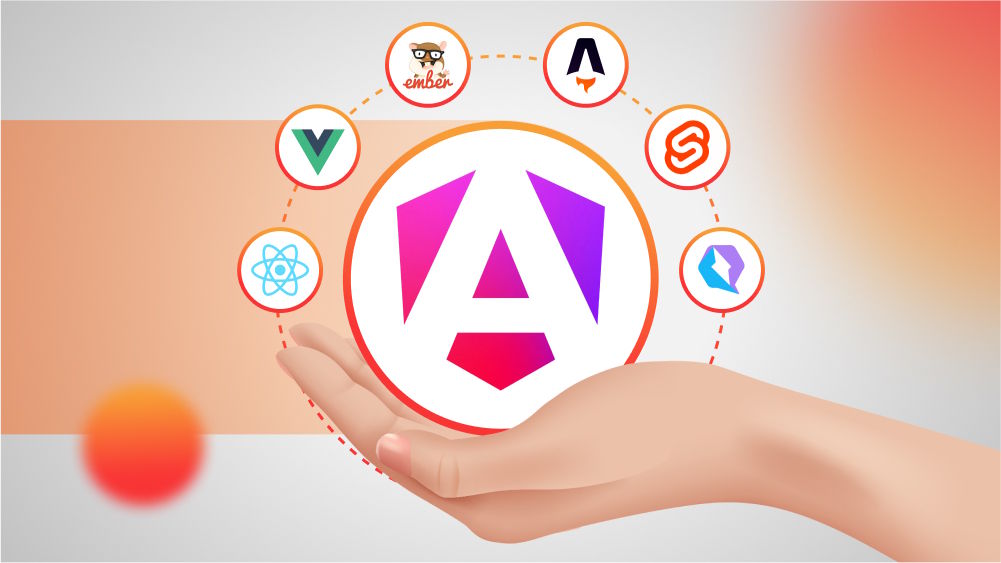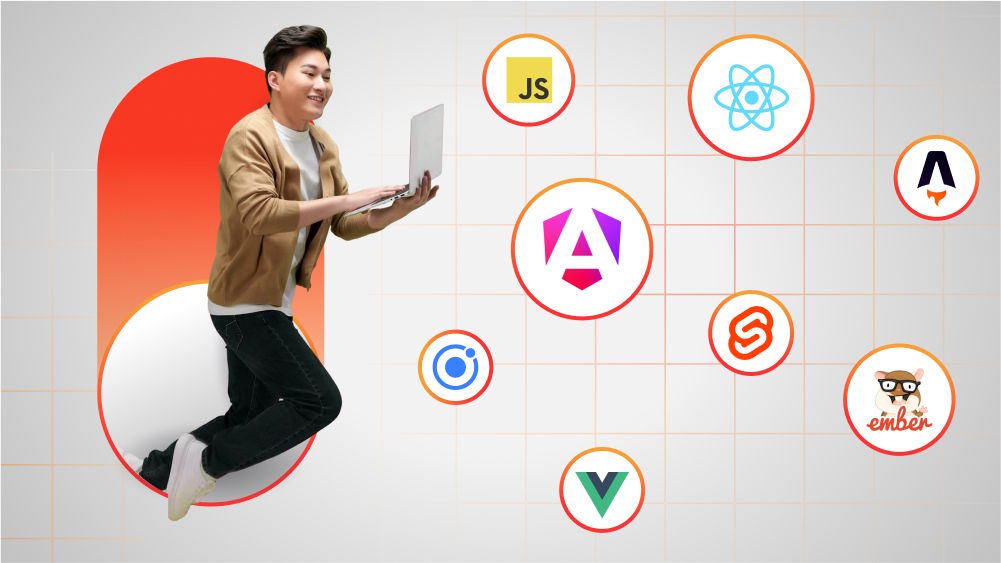Blockchain Software Development: A Pathway to Success in the Digital Age
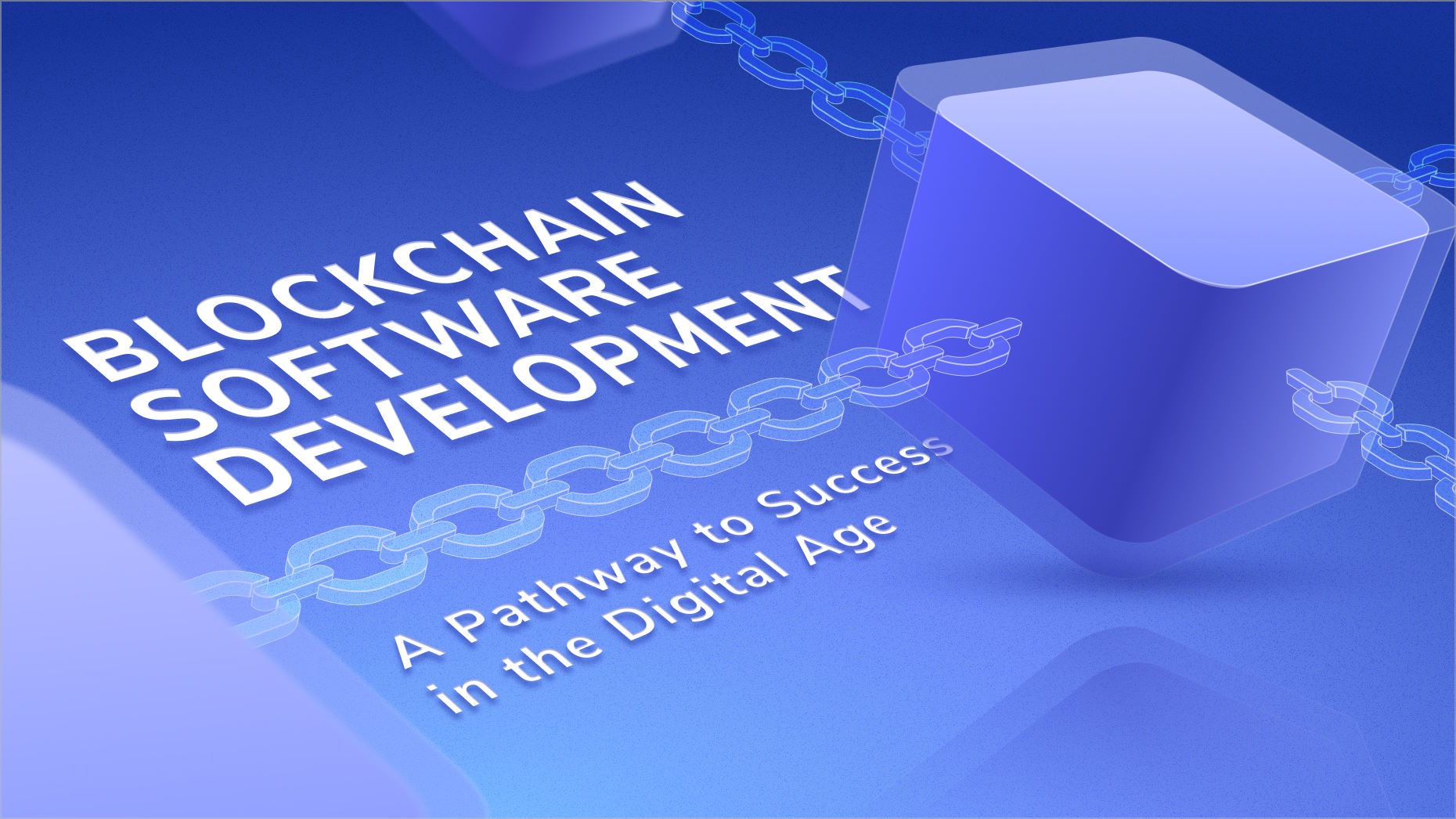
Content Map
More chaptersCreated in 2009 and rapidly gaining popularity in the technology industry, blockchain technology has proven its power with an incredible impact on many fields. Unfortunately, only a few individuals truly comprehend the meaning of this sophisticated network. The remarkable development of cryptocurrency, particularly Bitcoin, has brought blockchain technology to the public’s attention in recent years. Many individuals often claim that Bitcoin embodies the definition of blockchain. Correct, but not complete.
The blockchain industry, after many years of improvement along with the development of the latest software development technologies, has gone beyond the standards you once thought. Nowadays, more and more blockchain solutions appear to serve software development due to their outstanding advantages in security and efficiency.
The blockchain platform is famous for its high security to the point that it cannot be hacked. Is this a correct assessment of this future technology? Discover the truth behind blockchain software development in the digital landscape right in this article.
Understanding the Meaning of Blockchain Technology
Blockchain technology, to put it simply, is a decentralized and distributed ledger network that securely records and verifies transactions across multiple computers or nodes. Considered an advanced database mechanism that does not have centralized elements, blockchain creates a tamper-resistant environment that stores large amounts of information in a completely open and transparent manner.
In blockchain platforms, detailed information about records and transactions is digitally formatted and collected into blocks, forming a chain in a sequential and chronological order. Blocks are created continuously every time new information is recorded because of the limited capacity, which can vary depending on the blockchain protocols used.
Each block contains a unique and unchangeable cryptographic hash that links the new block to the previous one, forming an unbreakable information chain. As a result, blockchain networks create built-in mechanisms that are consistent and immutable, enhancing security and authenticity for all kinds of recorded data, such as tracking orders, accounts, payments, and other transactions.
Likewise, blockchain software development is defined as the process of developing, designing, and implementing software solutions using blockchain technology. To create complete decentralized applications (dApps), core blockchain developers are responsible for getting involved in creating and managing smart contracts, distributed applications, needed tools, and technologies that utilize the capabilities of blockchain networks.

Distinct Types of Blockchain Architecture
Blockchain architecture refers to the structure and design of a blockchain system. It is the blockchain architecture that determines the functionality, performance, scalability, and security of a blockchain app. There are many types of blockchain architecture that have different use cases and characteristics. Among them, public blockchain, private blockchain, consortium blockchain, and hybrid blockchain are the four most popular types in the blockchain ecosystem.
Public Blockchain
A public blockchain is a type of blockchain architecture that allows the participation of anyone as a user or validator in the network without specific permission or approval from central entities. By helping users to have the equal right to access, read, and validate the network through all servers and computers, public blockchain creates a decentralized and transparent digital environment where all real-time data and transaction processes are publicly visible to everyone.

This blockchain architecture enables trustless interactions by removing the mutual trust between user and user. Instead of placing trust in a central authority, public blockchain uses consensus mechanisms and cryptographic algorithms to ensure transparency and security. The act of exchanging or mining cryptocurrencies like Bitcoin and Ethereum is one of the clearest examples of the public blockchain.
Private Blockchain
In complete contrast to public blockchain, private blockchain solutions are managed and controlled by a unique author who has the right to grant permission for users to access and validate transactions over the network. Participants in this type of blockchain are usually trusted and known entities, including organizations, consortiums, businesses, government agencies, or particular individuals, and each of them possesses separate powers and roles decided by none other than the blockchain authority.

Since a private blockchain has a smaller network size compared to a public one, it can offer higher scalability and faster transaction processing. Private blockchain is a particularly suitable choice for applications that require privacy and confidentiality across the system, such as digital currency exchange networks for businesses like Ripple.
Consortium Blockchain
Consortium blockchains are semi-decentralized systems that are operated and governed by various organizations collaborating together as a consortium rather than just one entity. In this type of blockchain architecture, preselected are often objects that share common goals and benefits from sharing the responsibilities of validating and maintaining the blockchain network.

By implementing distinct privacy features for such networks, consortium blockchain is more proactive in protecting and controlling sensitive data shared among the involved members, leading to a higher level of security while benefiting from the transparency and immutability of the blockchain. Hyperledger Fabric and R3 Corda are two examples of consortium blockchains.
Hybrid Blockchain
Hybrid blockchain is a combination of public blockchain and private blockchain to create an innovative blockchain network that eliminates both types’ limitations while keeping and leveraging their strengths. Besides certain aspects of the network using public smart contracts, this architecture also includes private aspects that require permission to access. In this way, hybrid blockchain enables businesses to maintain control of confidential information and benefit from the distributed nature of blockchain technology simultaneously.

Hybrid blockchain is widely used by organizations that seek flexibility to tailor the architecture to their specific needs and requirements.
Blockchain Development through Different Versions
Blockchain has made remarkable progress since its launch. This technology has far-reaching implications beyond cryptocurrencies and is playing more diverse roles with each passing moment.
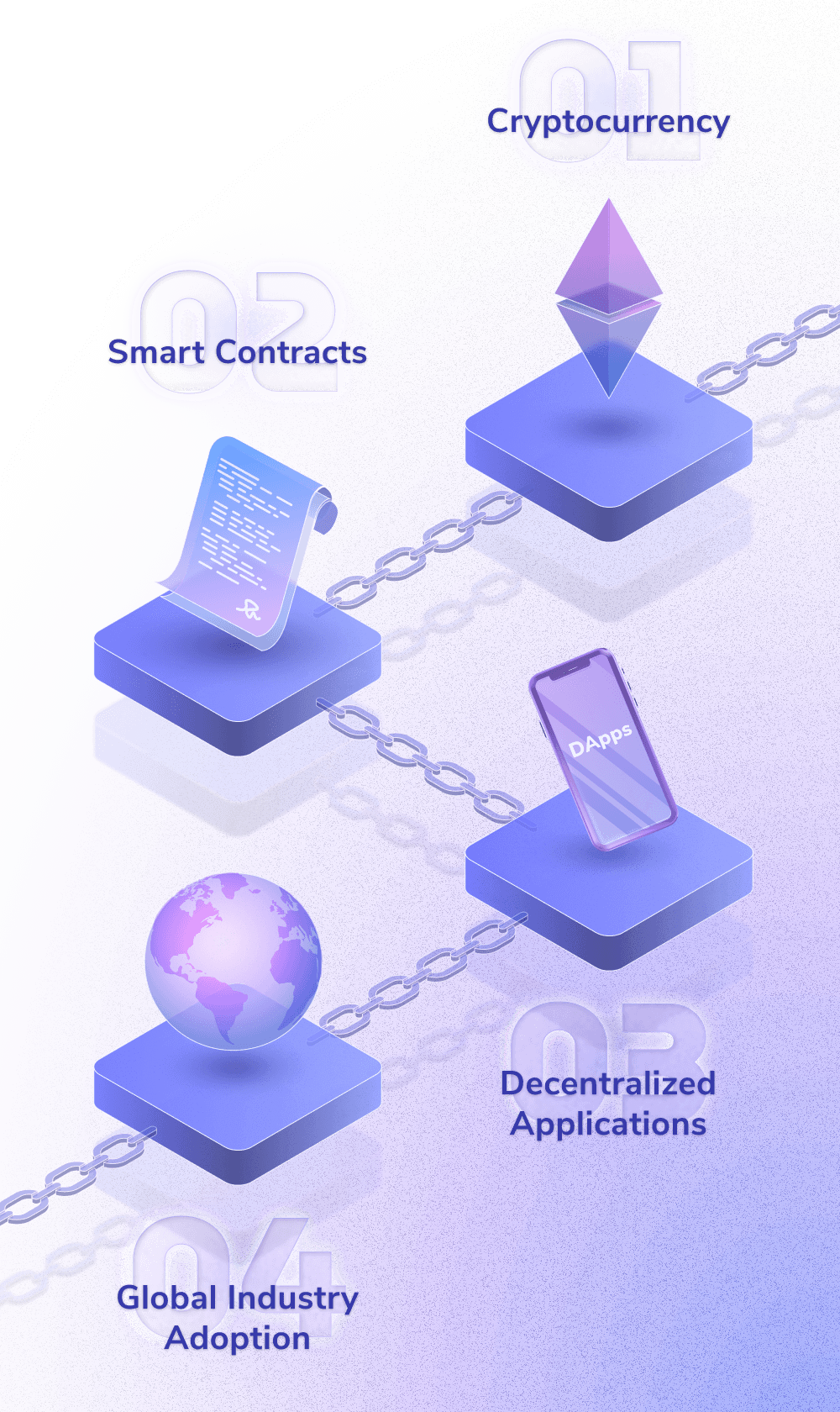
- Blockchain 1.0 - Cryptocurrency: The creation of Bitcoin in 2009 laid the foundation for decentralized digital currencies and introduced the new concept of distributed ledger technology. At its core, blockchain 1.0 mainly revolves around the revolution of transparent and secure peer-to-peer transactions without the need for intermediaries like banks. To date, many other cryptocurrencies besides Bitcoin have been born, demonstrating the strong explosion of currencies based on blockchain technology applications.
- Blockchain 2.0 - Smart Contracts: Smart contracts are the next application that helps blockchain expand beyond the financial and monetary sectors. Replacing traditional contracts written in hard and soft copies, smart contracts are self-executing contracts that are directly written into code without the intervention of intermediaries during the implementation process. The development of blockchain 2.0 allows the automation of many processes and programmable functionalities within blockchain networks with high precision and security.
- Blockchain 3.0 - Decentralized Applications (DApps): Blockchain technology receives the attention of many large and small businesses as it shifts towards decentralizing enterprise-level applications. Going beyond simple transactions and integrating more complex functionalities, DApps are not controlled by any centralized unit when automatically running on the blockchain or peer-to-peer networks, opening up opportunities for performance optimization in various industries.
- Blockchain 4.0 - Global Industry Adoption: The goal of blockchain 4.0 is to inherit and build upon the advancements made in previous iterations to meet the needs of business activities across various fields. In particular, blockchain 4.0 emphasizes the ability to move existing operations onto self-recording applications based on decentralized and trustless blockchain networks. This is considered a long-term vision. However, optimizing blockchain capabilities and receiving global recognition still pose challenges for most development teams.
Pros and Cons when Applying the Blockchain Network in Business Operations
The integration of any technological advancement can have a profound impact on business operations and software products. These influences may or may not be good. Blockchain is no exception. It is undeniable that blockchain technology is a huge step forward in the field of technology and human society. However, there are still pros and cons for businesses regardless of size, which we will discuss further in this section.

Pros of Blockchain Solution
Building Trust between No-relationship Entities
Blockchain applications encourage trust between no-relationship entities, although the definition of “traditional trust mechanisms” may even be lacking or unproven in this digital environment. This statement may appear nonsensical, but it is actually true. Based on its inherently decentralized nature, blockchain eliminates the need for an intermediary or centralized authority involvement in implementing processes.
Instead of depending on individual entities, trust is built through cryptographic algorithms and mathematical proofs. Any new transaction or data entry record that arises will be recorded by the blockchain system and become visible to all parties. This transparency ensures that all participants in the network, even without a direct relationship, can still access the same information and share the same goals.
Enhancing the Level of Security and Privacy
Permissionless blockchain network is difficult to hack or subject to the negative impact of cybersecurity risks. The operating principle and nature of blockchain technology can explain this. Characterized by a decentralized network operating under a distributed consensus mechanism where not just one but many participants will simultaneously maintain and validate the platform, blockchain makes it difficult for any entity intending to penetrate and manipulate the system without permission.
Unlike traditional conventional computer systems that store data on servers, real-time data existing in blockchain networks is recorded and stored across multiple computers or nodes. By using advanced cryptographic algorithms and consensus mechanisms, blockchain helps businesses track and trace the movement of assets or goods throughout every process, adding a significant layer of security to the application and enabling efficient auditing.
Not only that, once the information is recorded, there is no way for even participants to alter or remove it. The failure to find the vulnerability to a single point of failure in this complicated network causes many malicious actors to succumb to exploiting information for improper purposes.
Shortening Time Spending on Transaction Processes
Unlike traditional transaction systems, which are paper-heavy and human-depending, blockchain platform helps businesses streamline operations more effectively by leveraging its unique features. With blockchain technology, a transaction is completed within less than a second. How come?
By using smart contracts, blockchain automates and enforces the execution of transactions and agreements whenever predefined conditions are met. Users can authenticate their identities quickly using blockchain-based digital identities rather than going through lengthy verification procedures. This automation helps businesses reduce administrative overhead, eliminate the role of third-party intermediaries, and improve the overall transaction speed for participants, especially in cross-border transactions.
Besides the advantages of automation, the blockchain network, with its high level of transparency, also helps users more easily share data and collaborate between parties. While traditional methods require data exchange and reconciliation manually, blockchain provides only one source of truth and grants access to all participants within the network. Making this entire transaction transparent helps users reduce human-made errors and minimize delays.
Maximizing the Financial Strategy by Automation
Based on a study of Santander FinTech, distributed ledger technology could save the financial services industry between $15 billion and $20 billion annually by 2022. Applying blockchain technology to the operating system truly brings cost advantages. Instead of handling financial tasks manually, blockchain technology, with the self-executing smart contracts and decentralized nature, automates all processes and reduces delays and communication errors, leading to cost savings while ensuring performance.
Eliminating intermediaries also helps organizations minimize overhead expenses by narrowing transaction costs. Because of the peer-to-peer networks, businesses that need to transact globally and instantly can now receive payments through cryptocurrency and pay fewer transactional costs without any hurdles.
Furthermore, with outstanding features of immutability and transparency, blockchain enhances security and reduces all types of cybersecurity risks, such as fraud or data manipulation. Implementing blockchain now helps businesses avoid costly disruptions caused by cyberattacks or unauthorized modifications to records before they happen.

Cons of Blockchain Solution
Scalability Challenges
Similar to the evolution of big data, blockchain network is also developing at an increasingly dizzying pace. As the number of participants joining the network increases over time, the scalability issue becomes more evident. It heavily impacts the smoothness and transaction processing speed of the blockchain platform. Blockchain’s inherent design and consensus mechanisms are the two main factors causing this undeniable challenge.
Essentially decentralized applications, blockchain requires every user in the network to be responsible for validating and storing a copy of the entire blockchain when conducting transactions. This redundancy undeniably ensures security and data integrity for blockchain. However, it also results in increased storage requirements. The story becomes more complicated as the blocks are filled up quickly by every participating node, along with the growth of the number of transactions. When the block storage capacity reaches its limits, there will come a point when the blockchain network becomes overwhelmed, affecting the processing capabilities of individual nodes and hindering scalability.
Not to mention the network latency caused by the reliance on peer-to-peer communication of blockchain. Forcing nodes to communicate with each other to validate transactions makes geographic distance and network congestion suddenly matter and slows down the transaction processing time, affecting scalability. Fortunately, several solutions, such as proof-of-stake and Lightning Network, are gradually improving the scalability present on blockchain platforms.
Complexity and Implementation Struggle
Implementing and operating blockchain systems is more than a complex journey, especially for startups. Similar to other types of custom software products, businesses need to be equipped with extensive knowledge of this advanced technology before embarking on the process of building blockchain software development from scratch. After the requirement for technical expertise comes the issue of expense since developing a blockchain solution involves significant resource requirements and costs. The growing massive data volume forces businesses to invest heavily in infrastructure and related tool setups.
Where there is a need to integrate blockchain technology into existing applications, businesses may require utilizing interoperability protocols or even developing new custom solutions to ensure interoperability and compatibility between different blockchain platforms and legacy systems. Issues associated with security considerations, such as encryption and secure key management in the operation of such platforms, can add complexity to blockchain implementation. Although data vulnerability is rare in blockchain, this cannot help but happen. Blockchain, without regulatory oversight and a centralized party to interfere, can cause trouble for businesses if, unfortunately, involved in data protection, privacy, and anti-money laundering laws.
Energy Consumption
Not all blockchain solutions have the same energy consumption. The energy consumption of blockchain networks is mainly attributed to the consensus mechanisms used, like proof-of-work (PoW) algorithms, which require considerable computational power. Bitcoin is a popular blockchain network that exemplifies this. In order to receive the corresponding amount of cryptocurrency, the miners are incentivized to solve complex mathematical problems that require computationally significant power and energy consumption. Prolonging this over a long time, along with an increase in the number of miners in the future, makes these complex mathematical problems seem like simple problems, but in fact, they are not. This high energy consumption can be seen as a drawback from an environmental standpoint.
Nowadays, with the development and improvement of blockchain, more and more other consensus algorithms appear that have solved the energy-wasting problem. Private networks that limit the number of nodes within the network are a typical example of this situation.
A Step-by-step Guide on Developing Blockchain Applications
Building blockchain applications may vary from business to business depending on the purpose and distinction. By ignoring initial steps like identifying blockchain trends, use cases, and requirements, this section concentrates on primary periods that are highly specific.
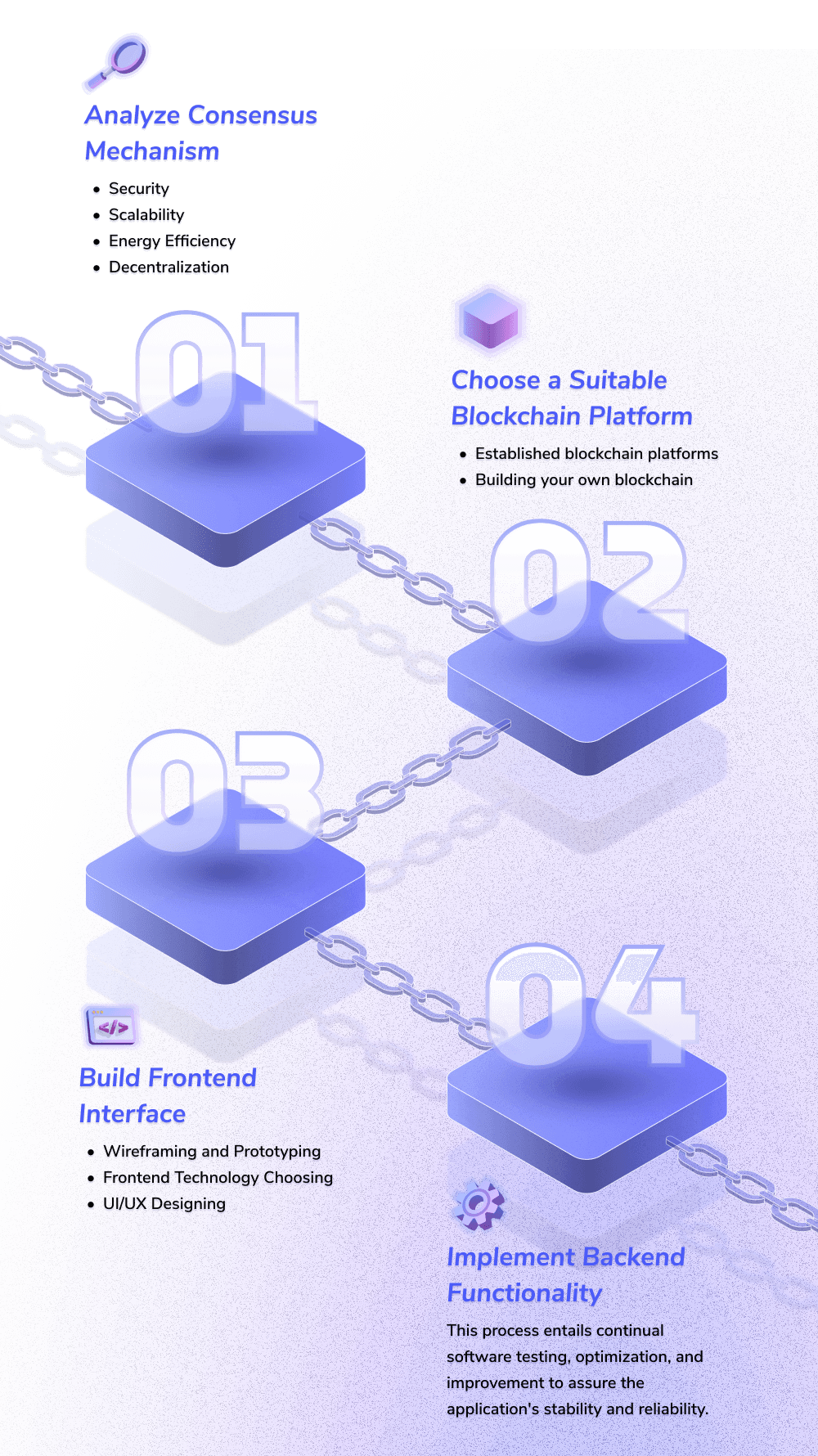

Analyzing a Consensus Mechanism
After completing the stage of drafting your business requirements and generating a product idea, it is time for you to enter the first critical step in developing a blockchain application - identifying a consensus mechanism. Consensus decides how consensus is achieved among network participants to validate and agree on the state of the blockchain. Nowadays, there are many types of consensus mechanisms from which you can choose. Among them, proof-of-work, proof-of-stake, or proof-of-authority are common names. No matter what you choose, consider some essential factors below to speed up the process.
- Security: It is recommended to choose consensus mechanisms that provide a high level of security against cybersecurity. Mechanisms capable of preventing double-spending, tampering, or unauthorized modifications to the blockchain are commonly used options.
- Scalability: Some consensus mechanisms are suitable for small networks with low transaction volumes, while some are not. Consider the scalability requirements of your blockchain project to meet the best solution.
- Energy Efficiency: If possible, join hands to protect by using consensus mechanisms that do not adversely affect environmental components. Proof-of-work is a typical mechanism that offers more energy-efficient alternatives.
- Decentralization: Not all consensus mechanisms have the same level of decentralization provided, and the chosen consensus will be the deciding factor in the number of nodes to participate in the consensus process.
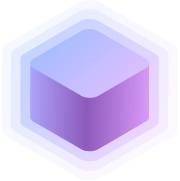
Choosing a Suitable Blockchain Platform
Choosing a blockchain platform plays an important role in the blockchain software development process because it directly affects the hiring requirements of your software development team and the functionality of your application. The blockchain platform serves as the foundation and infrastructure for creating and operating decentralized applications (DApps) on the blockchain.
At this stage, businesses have two options, including using an existing platform or building your own blockchain platform. There is nothing to say when you use established blockchain platforms, as they are the easiest way to complete your blockchain development product. However, if you need a platform that can meet your specific needs, building from scratch is a better idea. Both approaches have their advantages and considerations.
- Established blockchain platforms are an approach that offers time and budget benefits. With these pre-built capabilities, tools, and infrastructure, businesses have the opportunity to focus on their specific use case instead of starting from scratch. Some famous platforms, such as Ethereum, Hyperledger Fabric, Corda, etc., possess vibrant communities and rich sources of supporting information. In case of any difficulties during the development process, there is always help and access to resources from developers and businesses in the ecosystem.
- Building your own blockchain backward gives businesses complete control over the functionality and design of the network. By starting everything from scratch, businesses have the power to decide the level of customization of the platform, thereby precisely aligning the blockchain with specific use cases and requirements. Not only does it provide benefits in terms of control, but this approach also provides intellectual property rights and ownership of technology, helping businesses stand out from the general market and create a competitive advantage. Developing from the ground up is especially suited for industries with strict regulatory requirements, allowing for highly secure, tailor-made security protocols.

Building the Frontend Interface
Similar to other software products, the user interface has a significant impact on enhancing user experience in blockchain-based applications. How the user interface will appear depends on the aesthetic eye of the business and its specific project requirements and goals. However, there may be some special cases where building a frontend interface is not mandatory. Blockchain software used solely through third-party API, for instance, will not require frontend interface development.
The remaining blockchain software applications that involve direct user interaction, such as viewing data, submitting transactions, and interacting with smart contracts, are solutions that must provide interface components. The process of developing a frontend interface may include the following main steps.
- Wireframing and Prototyping: To visualize the structure of the application interface, businesses need to invest in creating low-fidelity prototypes and wireframes. Using support tools such as Adobe XD, Figma, and Sketch may help businesses map out the different screens and navigation flow.
- Frontend Technology Choosing: Each type of decentralized app corresponds to different frontend frameworks and technologies. Among them, some popular choices include React.js, Angular, or Vue.js. No matter which option you choose, businesses need to pay attention to factors such as compatibility, ease of development, and community support to optimize the performance of applications.
- UI/UX Designing: Creating visually appealing designs based on a business’s brand identity is an indispensable step to attracting and retaining users. It is recommended to focus on color scheme, iconography, and typography to maintain clarity and consistency in UI components.

Implementing Backend Functionality
It’s time to gather a team of experienced blockchain software developers and move on to the final and most important step in building blockchain software - implementing backend functionality. Implementing backend functionality in blockchain-based applications requires more than technical skills since this iterative process also involves continuous software testing, optimization, and improvement to ensure the stability and reliability of the application. With its high complexity, this process needs to be done carefully because just one mistake can cause great financial loss to the business.
There are some aspects businesses need to consider during this step, including:
- Implementing smart contracts on blockchain software for transparent and decentralized execution of business logic.
- Designing data management systems to store transaction data from the network.
- Enabling wallet functionality within the blockchain solutions to securely store and manage users’ digital assets.
- Developing APIs to enable seamless integration, ensuring smooth data flow and interoperability.
- Conducting security audits to identify vulnerabilities and protect the blockchain apps from potential attacks.
For faster time to market and the best product quality, don’t forget to look for developers with proven track records in the blockchain industry. A qualified core blockchain developer is someone who has an understanding and experience in core blockchain principles such as decentralized networks, cryptography, consensus algorithms, smart contracts, and distributed ledger systems. Your blockchain software development product may require continuous improvement in the future. However, don’t be afraid of this process because it is a good opportunity for you to keep up with the latest trends in blockchain technology, as it is a rapidly evolving field. Good luck!

Bring Your Idea to Life with Orient Software
Blockchain is a groundbreaking technology that offers a new way of managing databases and ensuring secure transactions. With the rapid development of digital transformation in recent years, blockchain technology has gradually overcome its shortcomings and promises to achieve many other significant milestones shortly.
If your business has the desire to be part of this blockchain revolution, don’t hesitate to make it happen today with your own blockchain software. A good quality product is indispensable without the help of a capable development team. However, hiring a qualified blockchain software developer these days is more than a complicated task due to developer shortages and cost requirements. As in every other field, businesses, regardless of size, are fiercely competitive in recruiting personnel. To solve this problem as quickly as possible and create a competitive advantage over competitors in the same segment, Orient Software is here to help.
With more than a decade of serving customers in diverse fields of operation from around the world, Orient Software provides a variety of different services, including blockchain development, and confidently fulfills what clients lack for a successful project. At Orient, we apply Agile software development methodology to optimize the production process and promote seamless collaboration between customers and dedicated teams, thereby implementing a product that creates partner satisfaction. Kick off your project and maximize its potential by contacting us now!


